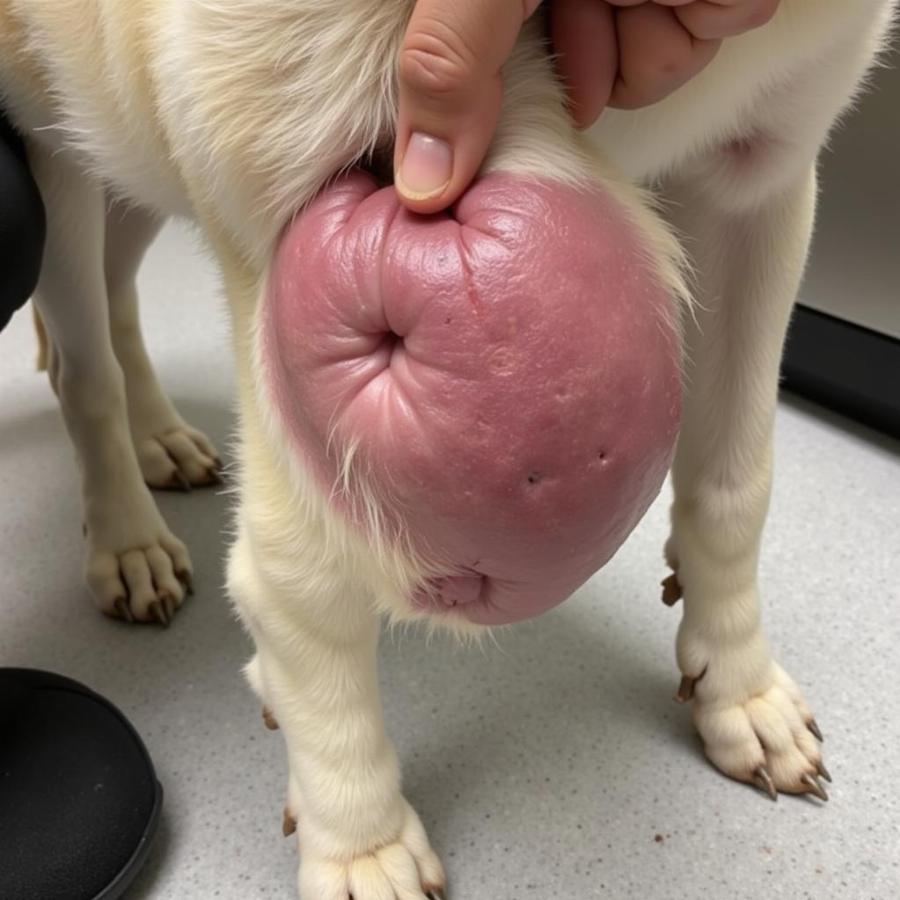Bruises on a dog can be alarming, but they aren’t always a cause for panic. Understanding what causes bruises, how to identify them, and when to seek veterinary care is essential for every dog owner. This article will guide you through everything you need to know about bruises on your canine companion, empowering you to provide the best possible care.
Identifying Bruises on Your Dog
Recognizing a bruise on a dog can be trickier than you might think, especially under a thick coat of fur. A bruise, also known as a contusion, occurs when small blood vessels under the skin break due to trauma. This leaked blood pools, resulting in a discoloration of the skin. In dogs, bruises often appear as a dark red, purple, or bluish mark. As the bruise heals, it may change color to green, yellow, or brown. Look for these marks particularly on areas with less fur, such as the belly or inner thighs. However, sometimes the only sign might be swelling or tenderness in a specific area. If your dog flinches when you touch a particular spot, it warrants further investigation.
Common Causes of Bruises in Dogs
Several factors can lead to bruises on dogs. Active, playful dogs are more prone to minor bumps and scrapes that can cause bruising, especially during rough play with other dogs. Accidents, such as bumping into furniture or falling, can also result in bruises. Certain medical conditions, like clotting disorders or platelet deficiencies, can make dogs more susceptible to bruising. Medications, particularly certain types of anti-inflammatory drugs, can also increase the risk. Senior dogs, with their thinner skin and less protective fat, are more prone to bruising as well.
When to Worry About Bruises on Dogs
While many bruises are harmless and heal on their own, some warrant veterinary attention. If the bruise is accompanied by significant swelling, pain, or lameness, it’s crucial to consult your veterinarian. Similarly, if the bruise doesn’t seem to be healing or gets larger, it could indicate a more serious underlying issue. Multiple unexplained bruises, especially if they appear spontaneously, should also be checked by a vet. Finally, if you suspect your dog has ingested a toxin or been bitten by another animal, immediate veterinary care is essential. Why is my dog limping but not crying? This could be related to a bruise, so it’s best to consult a vet.
 Signs of a serious bruise on a dog
Signs of a serious bruise on a dog
Treating Bruises on Dogs
Most minor bruises will heal on their own within a few weeks. Applying a cold compress to the affected area can help reduce swelling and discomfort. Restricting your dog’s activity can also prevent further injury and promote healing. Your veterinarian may recommend pain medication if your dog is experiencing significant pain. In some cases, they may also recommend further diagnostic tests to rule out underlying medical conditions. You can find more information about swelling on a dog’s face, which can sometimes be related to bruising, on our dedicated page. Similarly, it’s important to be aware of what foods your dog can safely consume, as some can impact their health and potentially worsen bruising. For example, can dogs eat persimmon? Check out our article to find out.
Preventing Bruises on Dogs
While it’s impossible to completely prevent all bruises, certain precautions can minimize the risk. Providing a safe and secure environment for your dog is crucial. This includes keeping hazardous objects out of reach, ensuring your dog has a comfortable and supportive sleeping area, and supervising playtime with other dogs. Regular veterinary check-ups can help identify and address any underlying medical conditions that may increase the risk of bruising. Can dogs get bruises? Yes, and understanding the causes, symptoms, and treatment options is key to ensuring your furry friend’s well-being.
Conclusion
Bruises on dogs can be concerning, but understanding the causes, symptoms, and treatment options empowers you to provide the best possible care. By knowing when to seek veterinary attention and implementing preventative measures, you can help keep your canine companion happy and healthy. If you have any further concerns about bruises on your dog, don’t hesitate to consult your veterinarian.
FAQ
- What does a bruise look like on a dog? Bruises on dogs can appear as dark red, purple, bluish, green, yellow, or brown marks on the skin.
- How long does it take for a dog bruise to heal? Most minor bruises heal within a few weeks.
- Should I take my dog to the vet for a bruise? If the bruise is accompanied by significant swelling, pain, lameness, or doesn’t seem to be healing, consult your vet.
- Can I treat my dog’s bruise at home? Applying a cold compress and restricting activity can help, but always consult your vet before starting any home treatment.
- How can I prevent my dog from getting bruises? Provide a safe environment, supervise playtime, and schedule regular vet check-ups.
- Are some dogs more prone to bruising than others? Yes, senior dogs and those with certain medical conditions are more susceptible.
- What if my dog has multiple bruises? Multiple unexplained bruises warrant immediate veterinary attention.
More Questions? Explore More at Beaut Dogs!
- Learn more about dog health and wellness on our website.
- Discover information on specific breeds and their unique needs.
Beaut Dogs is your trusted source for all things canine, offering expert advice and valuable information on dog breeds, care, and well-being. From understanding specific health concerns like bruises to providing breed-specific guidance, Beaut Dogs is here to support you in your journey as a dog owner. When you need expert advice, contact us at Email: [email protected] to get detailed and accurate answers from Beaut Dogs. Visit us at https://beautdogs.com to explore our extensive library of resources and learn more.